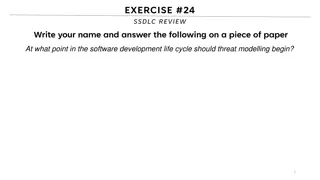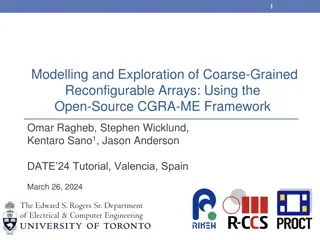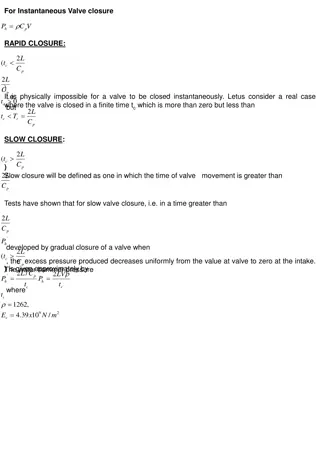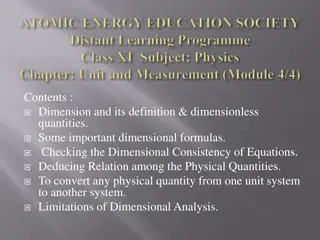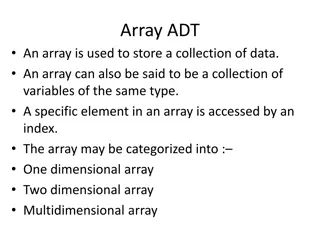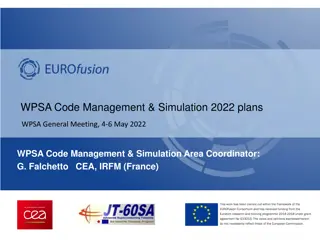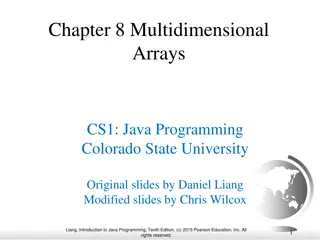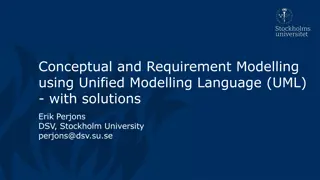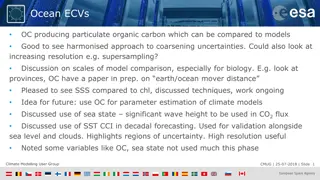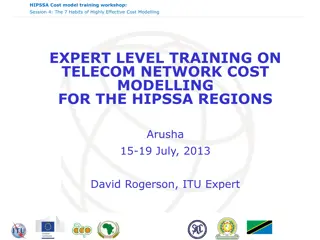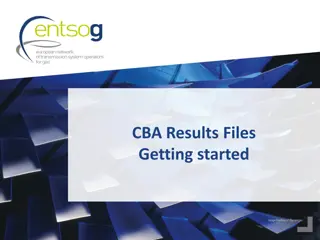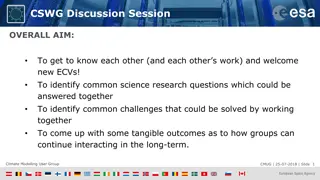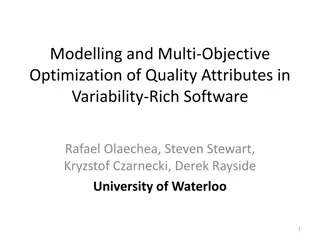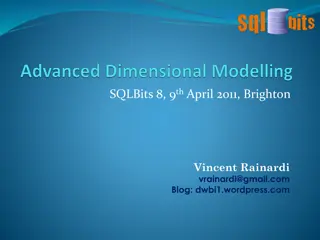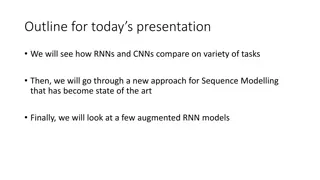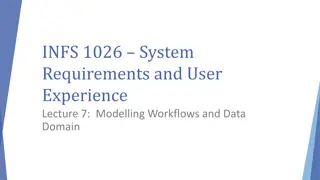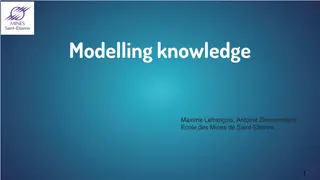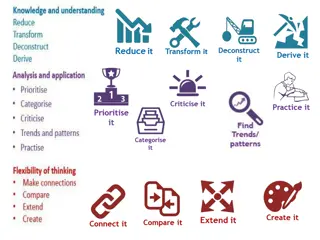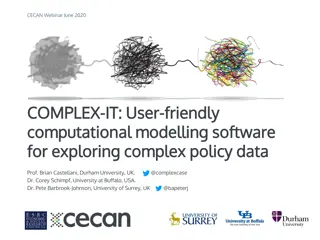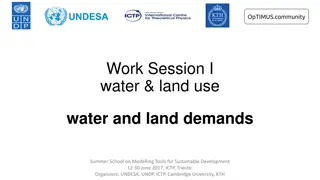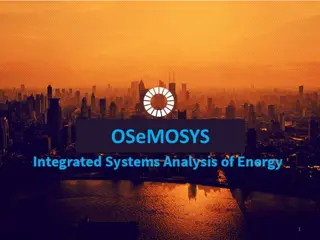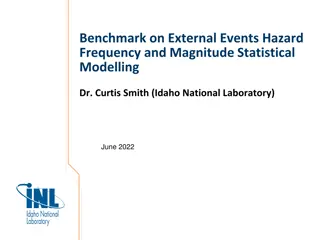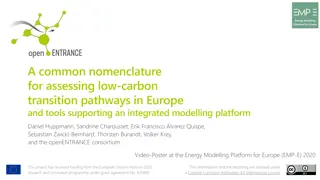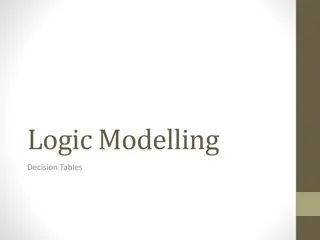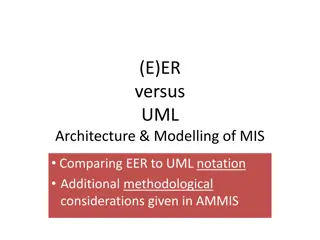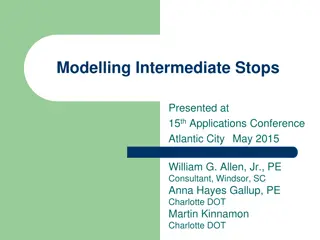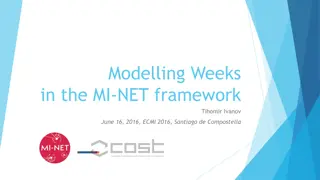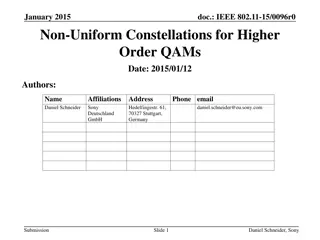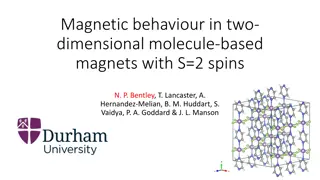Business Modelling and Innovation for Holistic Understanding and Growth
Explore the CGC Aarhus University International Summer Internship Program in Denmark focusing on business modelling and innovation. The program offers a comprehensive learning experience for graduate and postgraduate students, including online sessions and weeks in Denmark. Discover the significance
4 views • 14 slides
Tradeoffs Between Water Savings and GHG Emissions in Irrigated Agriculture
This study examines the tradeoffs between water savings, economic impact, and greenhouse gas emissions resulting from technological changes in the irrigation industry. Key objectives include estimating water savings for different crops, quantifying GHG emissions from new irrigation technologies, and
0 views • 24 slides
Modelling Estuarine Habitats in the Upper Sea Scheldt: Human-Induced Adaptations
Explore a research study on modelling estuarine habitats in the Upper Sea Scheldt under various human-induced channel and floodplain adaptations. The study examines the impact of interventions on habitat size, water quality, ecosystem, and more, providing insights into the future of the estuarine en
3 views • 13 slides
Software Development Life Cycle - Threat Modelling Initiation
Threat modelling should commence at the early stage of the software development life cycle to identify potential security risks and vulnerabilities effectively. It should ideally begin during the requirement analysis and continue throughout development, testing, and maintenance phases to ensure robu
3 views • 27 slides
Modelling and Exploration of Coarse-Grained Reconfigurable Arrays Using CGRA-ME Framework
This content discusses the CGRA-ME framework for modelling and exploration of Coarse-Grained Reconfigurable Arrays (CGRA). It covers the objectives, architecture description, inputs required, and tools included in the framework. CGRA-ME allows architects to model different CGRA architectures, map ap
2 views • 33 slides
Techniques in Fluid Mechanics: Dimensional Analysis
Dimensional analysis is a powerful tool used in engineering to investigate problems in fluid mechanics. By identifying key factors in physical situations, dimensional analysis can establish relationships between them, providing qualitative solutions that can be further refined experimentally. This t
0 views • 5 slides
Understanding Dimensional Analysis in Physics
Dimensional analysis in physics involves defining dimensions of physical quantities, determining dimensionless quantities, checking dimensional consistency of equations, converting units, and exploring the limitations and applications of dimensional analysis. By understanding dimensions and dimensio
0 views • 14 slides
Understanding Non-Dimensional Numbers in Fluid Mechanics
Non-dimensional numbers play a crucial role in understanding fluid motion. This includes Reynolds Number for inertia and viscous forces, Froude Number for gravity effects, Cauchy Number for compressible flows, and Mach Number for elasticity forces. These numbers help in analyzing pipe friction, flow
1 views • 10 slides
Understanding Arrays: Overview and Examples
Arrays are essential data structures used to store collections of data in programming. They can be one-dimensional, two-dimensional, or multidimensional, accessed by specific indices. Learn about linear arrays, indexing methods, and two-dimensional arrays through detailed explanations and visual rep
1 views • 33 slides
EUROfusion WPSA Code Management and Modelling Activities 2021-2022
EUROfusion's WPSA Code Management and Modelling activities for 2021-2022 focus on developing operation-oriented tools and synthetic diagnostics for JT-60SA scientific exploitation. The tasks include discharge simulator development, breakdown simulator optimization, Energetic Particle stability analy
0 views • 12 slides
Understanding Two-Dimensional Arrays in Java Programming
Explore the concept of two-dimensional arrays in Java programming through examples and illustrations. Learn how to declare, create, and initialize two-dimensional arrays efficiently to represent matrices or tables. Discover the benefits of using multi-dimensional arrays for data organization and man
1 views • 25 slides
Comprehensive Overview of Freezing Time Methods in Dairy Engineering
Neumann, Tao, and Non-Dimensional methods are key approaches for determining freezing times in unsteady state heat transfer processes in dairy engineering. The Neumann Problem, Tao Solutions, and Cleland and Earle Non-Dimensional Equation offer distinct equations and models to calculate freezing tim
1 views • 8 slides
Understanding Conceptual and Requirement Modelling Using UML
Enterprise and system models play a crucial role in the business world. This collection of images showcases various aspects of conceptual and requirement modelling using Unified Modelling Language (UML). From business process models to human interactions with software systems, these visual represent
1 views • 92 slides
Stochastic Coastal Regional Uncertainty Modelling II (SCRUM2) Overview
SCRUM2 project aims to enhance CMEMS through regional/coastal ocean-biogeochemical uncertainty modelling, ensemble consistency verification, probabilistic forecasting, and data assimilation. The research team plans to contribute significant advancements in ensemble techniques and reliability assessm
0 views • 28 slides
Insights from Climate Modelling User Group Meeting - July 2018
Discussion at the Climate Modelling User Group meeting highlighted the use of Ocean ECVs, with a focus on organic carbon production and model comparisons. Key topics included increasing resolution, biogeochemistry predictions, and validation using OC CCI data. Various WP projects were also discussed
1 views • 4 slides
Understanding N-Gram Models in Language Modelling
N-gram models play a crucial role in language modelling by predicting the next word in a sequence based on the probability of previous words. This technology is used in various applications such as word prediction, speech recognition, and spelling correction. By analyzing history and probabilities,
0 views • 101 slides
Expert Training on The 7 Habits of Highly Effective Cost Modelling
In this workshop session by David Rogerson, an ITU expert, participants learn the key habits of successful cost modelling in the telecom industry. The session covers identifying, illustrating, remembering, and implementing these habits for effective regulatory cost-modelling practices, with a focus
0 views • 23 slides
Understanding CBA Results Files and Modelling Outputs
The content provides a detailed guide on accessing and utilizing CBA Results Files, including tips on reading the CBA Methodology and understanding various indicators and economic templates. It also highlights the importance of analyzing disrupted rates, quantities, flexibility, and other key compon
0 views • 15 slides
Climate Modelling User Group Discussion Session Overview
The Climate Modelling User Group (CMUG) discussion session aims to foster collaboration among members, welcome new participants, identify common research questions and challenges, and establish long-term interaction mechanisms. The session includes presentations on ECV consistency and planetary visi
0 views • 15 slides
Modelling and Optimization of Quality Attributes in Software Variability
Modelling and multi-objective optimization of quality attributes in variability-rich software is crucial for customizing software functionality to meet stakeholders' diverse needs. This involves addressing conflicting quality requirements such as cost, reliability, performance, and binary footprint
0 views • 34 slides
Advanced Dimensional Modelling: Strategies for Effective Data Handling
Explore advanced techniques in dimensional modelling such as handling rapidly changing dimensions, snowflaking dimensions, and dealing with very large dimensions. Learn about different types of dimension structures, fact tables, and their combinations to optimize data storage and retrieval efficient
0 views • 44 slides
Understanding Cross-Classified Models in Multilevel Modelling
Cross-classified models in multilevel modelling involve non-hierarchical data structures where entities are classified within multiple categories. These models extend traditional nested multilevel models by accounting for complex relationships among data levels. Professor William Browne from the Uni
0 views • 13 slides
Exploring RNNs and CNNs for Sequence Modelling: A Dive into Recent Trends and TCN Models
Today's presentation will delve into the comparison between RNNs and CNNs for various tasks, discuss a state-of-the-art approach for Sequence Modelling, and explore augmented RNN models. The discussion will include empirical evaluations, baseline model choices for tasks like text classification and
0 views • 20 slides
Exploring Vortex Dynamics in Solar Chromosphere and Two-Dimensional Turbulence
Detailed exploration of various vortex dynamics including MHD Rankine vortex, Rankine vortex in general hydrodynamic, stable 2-dimensional vortex, Burgers-Rott vortex, and MHD equations in cylindrical coordinates. Provides insights into exact solutions, properties, and energy distribution of differe
0 views • 15 slides
Modelling Workflows and Data Domain in System Requirements and User Experience
In this lecture, the focus is on modelling workflows and data domain in the context of system requirements and user experience. The topics covered include recap of use cases, use case diagrams, descriptions, events initiated by stakeholders, defining elements for each use case, use case diagrams, an
0 views • 56 slides
Fast High-Dimensional Filtering and Inference in Fully-Connected CRF
This work discusses fast high-dimensional filtering techniques in Fully-Connected Conditional Random Fields (CRF) through methods like Gaussian filtering, bilateral filtering, and the use of permutohedral lattice. It explores efficient inference in CRFs with Gaussian edge potentials and accelerated
0 views • 25 slides
Understanding Modelling Knowledge and Knowledge Representation
Explore the significance of modelling knowledge through knowledge representation, making it explicit, independent, and reusable. Learn why knowledge representation is essential and how it facilitates exchange, query, inference, and visualization. Delve into examples of knowledge application in vario
0 views • 30 slides
Understanding Scientific Modelling in Atomic Theory
Explore the use of scientific modelling in atomic theory through a learning journey covering topics like the atom, hazards, risks, and atomic structure. Engage in a True or False task to test your knowledge and delve into a video timeline on the discovery of silver and gold elements.
0 views • 11 slides
Introduction to COMPLEX-IT: A User-Friendly Computational Modelling Software for Policy Data Exploration
Explore the capabilities of COMPLEX-IT, a web-based software tool designed to enhance researchers' access to computational social science tools. It offers a compact platform integrating case-based modelling, artificial intelligence, scenario analysis, and more. With an intuitive interface and quick
0 views • 14 slides
Sustainable Development Modelling Tools at ICTP Trieste
In June 2017, a Summer School on Modelling Tools for Sustainable Development was organized at ICTP, Trieste. The sessions covered topics like representation of water supply and demand, incorporation of land use in modelling, energy system diagrams, and structures of energy and water systems models.
0 views • 30 slides
Understanding OSeMOSYS: Energy System Modelling and Linear Programming
Energy systems modelling with OSeMOSYS involves linear programming to determine the optimal energy system configuration. The tool considers factors like demand, available technologies, emissions, and constraints to minimize costs over decades. Linear programming, developed during World War II, plays
0 views • 15 slides
Statistical Modelling of Hazard Frequency and Magnitude in External Events
Dr. Curtis Smith from Idaho National Laboratory presented a benchmark on External Events Hazard Frequency and Magnitude Statistical Modelling. The background involves the Working Group on External Hazards (WGEV) addressing the challenges in formulating and assessing external event initiating events
0 views • 11 slides
Developing a Modelling Platform for Low-Carbon Transition Pathways in Europe
This project focuses on creating a transparent and integrated modelling platform for assessing low-carbon transition pathways in Europe. Key components include a common data format, a common nomenclature, and model integration via a central data hub. The aim is to facilitate understanding of the ene
0 views • 6 slides
Decision Tables in Logic Modelling for Rule-based Decision-making
Explore the process of creating decision tables in logic modelling to make rule-based decisions. Understand the conditions, actions, and resulting rules through practical examples involving scenarios like campus burglar alarms and customer mailings. Simplify complex decision-making logic for efficie
0 views • 11 slides
Comparing EER and UML Architecture for Modelling of MIS
This discussion delves into the comparison between Entity-Relationship (EER) and Unified Modeling Language (UML) architectures for the modelling of Management Information Systems (MIS). It explores the differences in notation, methodological considerations, specialisation hierarchies, and categorisa
0 views • 16 slides
Insights into Modelling Intermediate Stops and Tour-Based Models in Transportation Planning
Explore the concept of intermediate stops in transportation modelling, including the development of a new tour-based model in Charlotte. Learn about the challenges faced in modelling stops and the estimation process using the Logit model. Discover how tour frequency, main destination choice, number
0 views • 19 slides
Opportunities at Modelling Weeks: Join for Real-Life Problem Solving
Explore the world of Modelling Weeks where small teams of students work on real-life problems under experienced instructors. Benefits include networking, teamwork, presenting results, and preparing scientific documents. Organize your own Modelling Week with support from MI-NET, focusing on PhD stude
0 views • 11 slides
Non-Uniform Constellations for Higher Order QAMs in January 2015
Non-uniform constellations (NUCs) offer improved performance compared to uniform constellations (UCs) in the context of higher order QAMs discussed as potential technology for next-generation 60GHz OFDM. The use of NUCs optimizes the location of constellation points, ensuring robust and weak bits ca
0 views • 10 slides
Magnetic Behavior in Two-Dimensional Molecule-Based Magnets
Understanding the magnetic behavior in two-dimensional molecule-based magnets with S=2 spins, exploring MnF3(pyz) with Jahn-Teller elongated Mn(III) octahedra, and discussing the crossover between classical and quantum regimes. The research involves DFT calculations for 1D antiferromagnetic systems,
0 views • 8 slides
Robust High-Dimensional Classification Approaches for Limited Data Challenges
In the realm of high-dimensional classification with scarce positive examples, challenges like imbalanced data distribution and limited data availability can hinder traditional classification methods. This study explores innovative strategies such as robust covariances and smoothed kernel distributi
0 views • 10 slides



